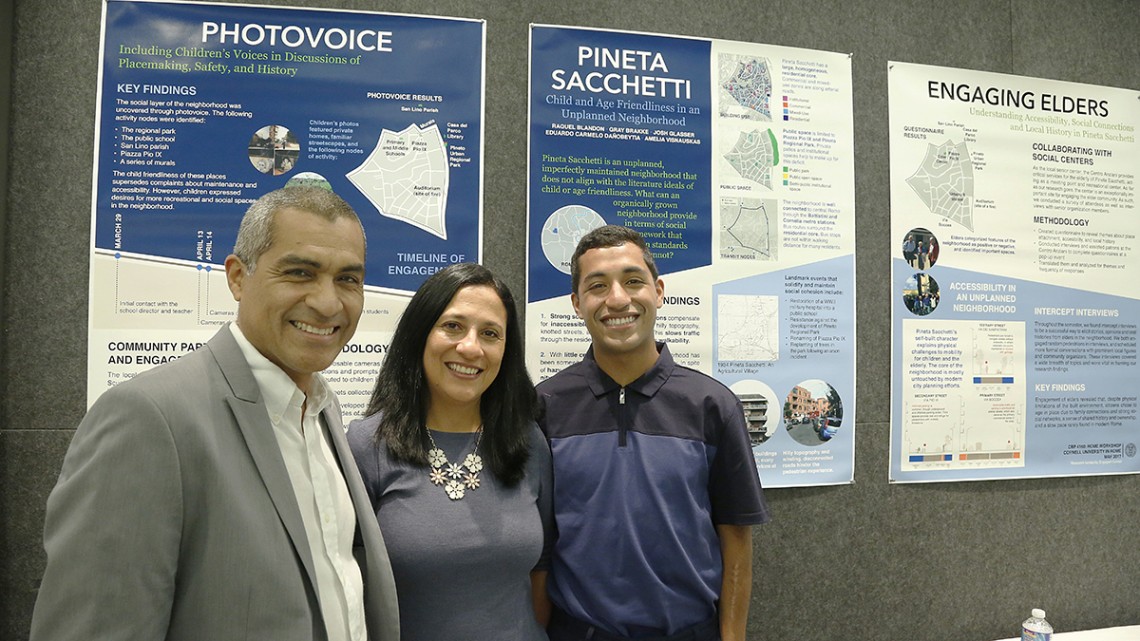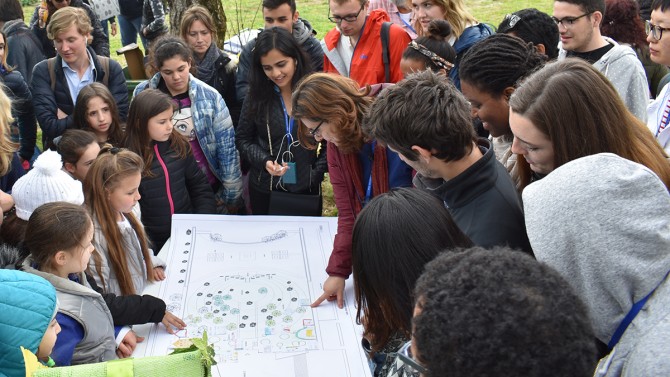
Eduardo Carmelo ’18, right, with his parents during a reception following the Rome Workshop in Milstein Hall.
Student work in Italy and upstate N.Y. informs intergenerational communities
By Daniel Aloi
City and regional planning students presented community-engaged research and case studies from Rome, Italy, and Sullivan County, New York, at a workshop on campus Sept. 22, focused on the factors that make communities hospitable to children and the elderly.
The students observed that social aspects of communities and neighborhoods – libraries, schools, markets and community-oriented organizations – can improve conditions for children and senior citizens, especially where the physical landscape presents deficiencies or limitations, whether in land-use planning, housing, transportation, services or public space.
“The Rome Workshop: Building Child and Age Friendly Communities: Lessons From Rome ... for New York” was organized by professor of city and regional planning Mildred E. Warner, M.S. ’85, Ph.D. ’97. The half-day event in Milstein Hall, attended by planners from around the region and several of the students’ family members, included a research poster session, a panel of regional planners and community leaders, and Warner and doctoral student Xue Zhang presenting national survey data on multigenerational planning.
During the College of Architecture, Art and Planning’s Cornell in Rome program last spring, students in the urban studies workshop course, co-taught by Warner and Rome faculty, assessed four peripheral neighborhoods, interviewed residents and prepared case studies. Planning students from Cornell have conducted more than two dozen Rome neighborhood studies since 2004.
In their presentation, “Il Tufello: Building a Strong Community Despite the Odds,” Graham Murphy ’18 and Tishya Rao ’18 discussed a low-income neighborhood made more livable by its infrastructure and social institutions, “creating social cohesion and building a sense of place.” These points of cohesion included a library, Biblioteca Ennio Flaiano; a cooperative market frequented by elderly residents; a public gym used by antifascist community organizers; and Defrag, a group organizing all-ages events to build community by countering class and ethnic differences.
Amelia Visnauskas ’18 and Eduardo Carmelo Danobeytia ’18 detailed in “Pineta Sacchetti: A Village Without a Name” how their group found a strong sense of community identity in an unplanned but age-friendly neighborhood. Highlighting “alternative methods of engagement,” the students engaged children in a Photovoice exercise and conducted interviews with seniors, compiling impressions that revealed social assets making the neighborhood a good place to live.
In “San Giovanni: Living Next to a Transit Corridor,” Madeleine Galvin ’18 and Shareef Hussam ’18 said their group conducted a livability audit of the densely populated area to address the negative impacts of transit-oriented development on children and elders, such as congestion, pollution and the deterioration of public spaces. Their research underscored the need for thoughtful planning around new transit development.
Adam Bronfin ’18 and Kai Walcott ’18, in a study of Piazza Alessandria, “Can Regeneration Be Multigenerational?,” questioned how different age groups respond to urban regeneration where the neighborhood “is both physically and demographically old.” They elicited residents’ perceptions of the effects of recent change on child- and age-friendliness, and looked at “the potential and challenges of building coalitions between the elderly and young in urban planning.”
In rural upstate New York, Erin Tou ’18 and Rachel Stein ’18 interned last year in partnership with Cornell Cooperative Extension to identify needs, barriers and opportunities in Sullivan County for seniors and families with children. They asked residents and providers about access to health services, nutritional and recreational resources, and challenges to access including difficulties in transportation and scheduling.
In a statewide community health assessment in 2013, Sullivan County ranked 61st out of 62 counties in health outcomes, with indicators including one of the highest premature death rates (1 in 3) in the state (17.5 percent of its 77,000 residents live in poverty, as do 1 in 4 families with children, Stein noted). A coalition formed “to connect agencies and take concrete steps to address community needs,” Tou said.
After a demographic analysis of the county the students interviewed 15 service providers before preparing paper and online surveys. They distributed 300 surveys (receiving 270 responses) and interviewed residents at 13 sites across the county, including libraries, parks and soup kitchens, she said.
Scheduling appointments for elderly and other residents who rely on public transportation was the barrier most frequently cited in the survey, as well as cost and quality of services. Residents also noted “limited youth services – youth programs were identified as the No. 1 need,” Tou said. She and Stein are compiling analytical data from the research.
“Age-friendly planning requires attention to all ages,” Warner said. “Too often physical design is given primary emphasis, but it may be hardest to change. Attention to services and community engagement can help make communities more age friendly despite poor physical design.”
The work in Rome was supported by an Engaged Opportunity Grant. The Sullivan County project received Cooperative Extension Student Project funding.
The Rome and Sullivan County work was profiled at a webinar in June sponsored by the American Planning Association and a webinar for World Town Planning Day, Nov 8.
Media Contact
Get Cornell news delivered right to your inbox.
Subscribe